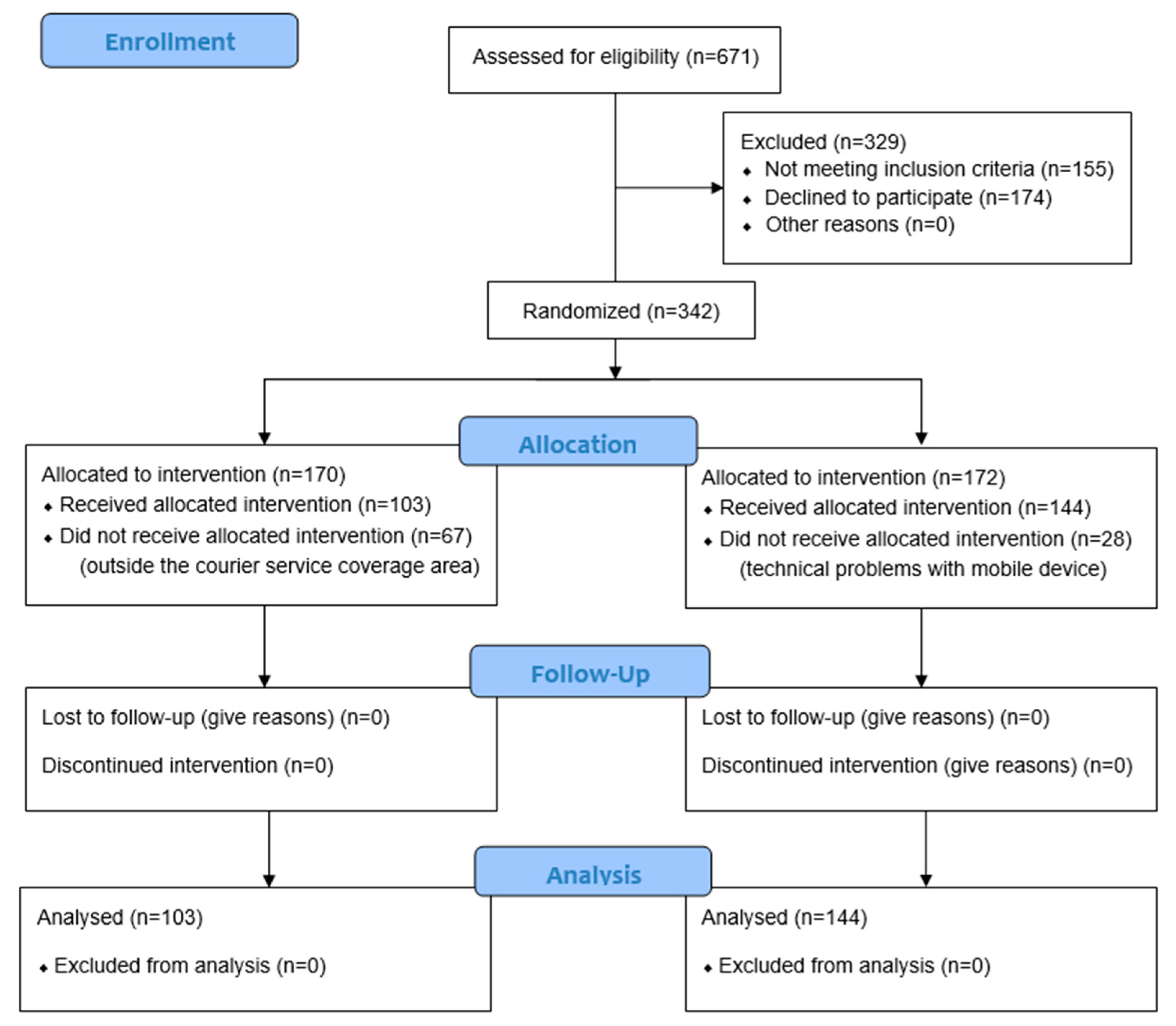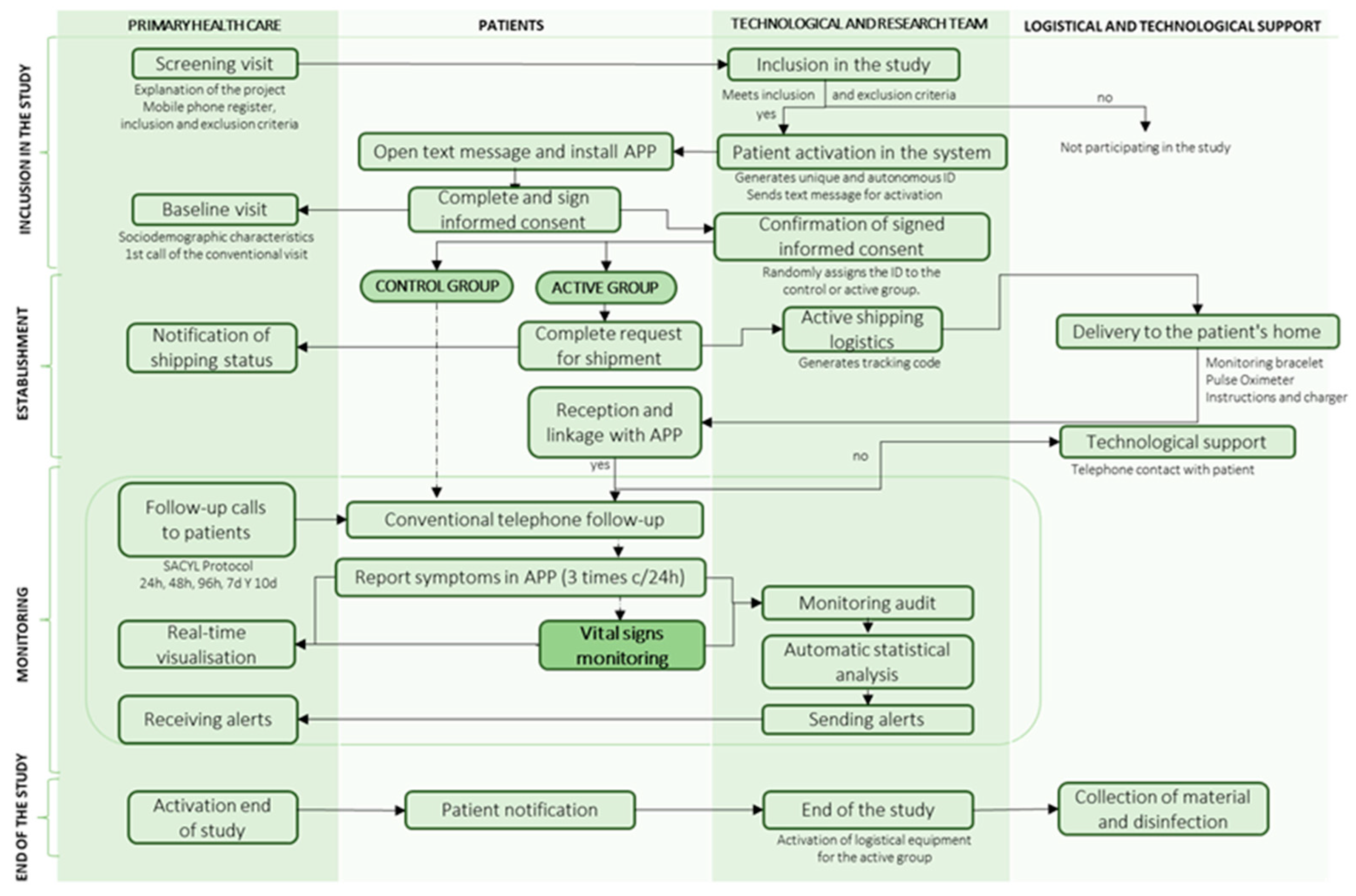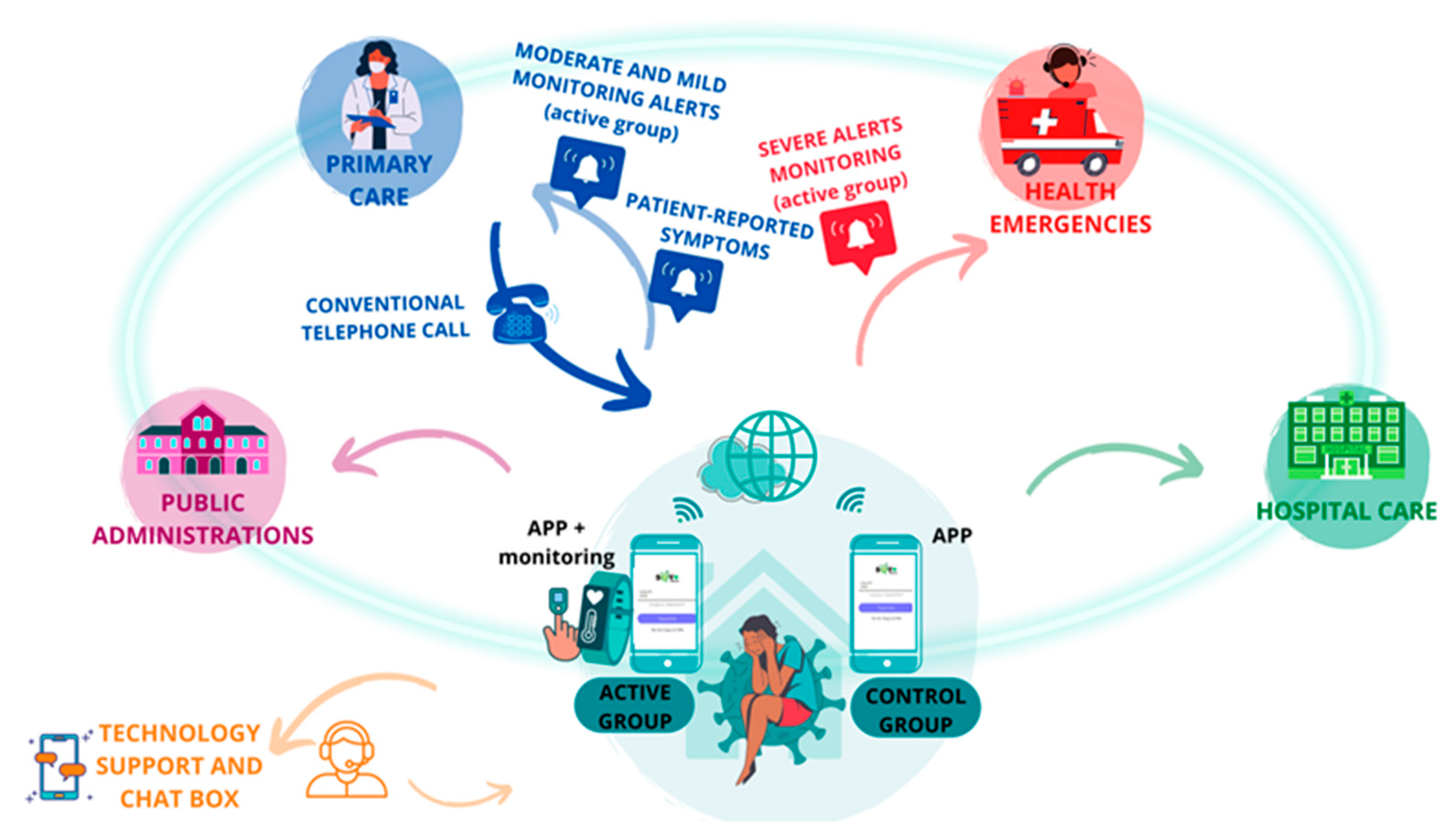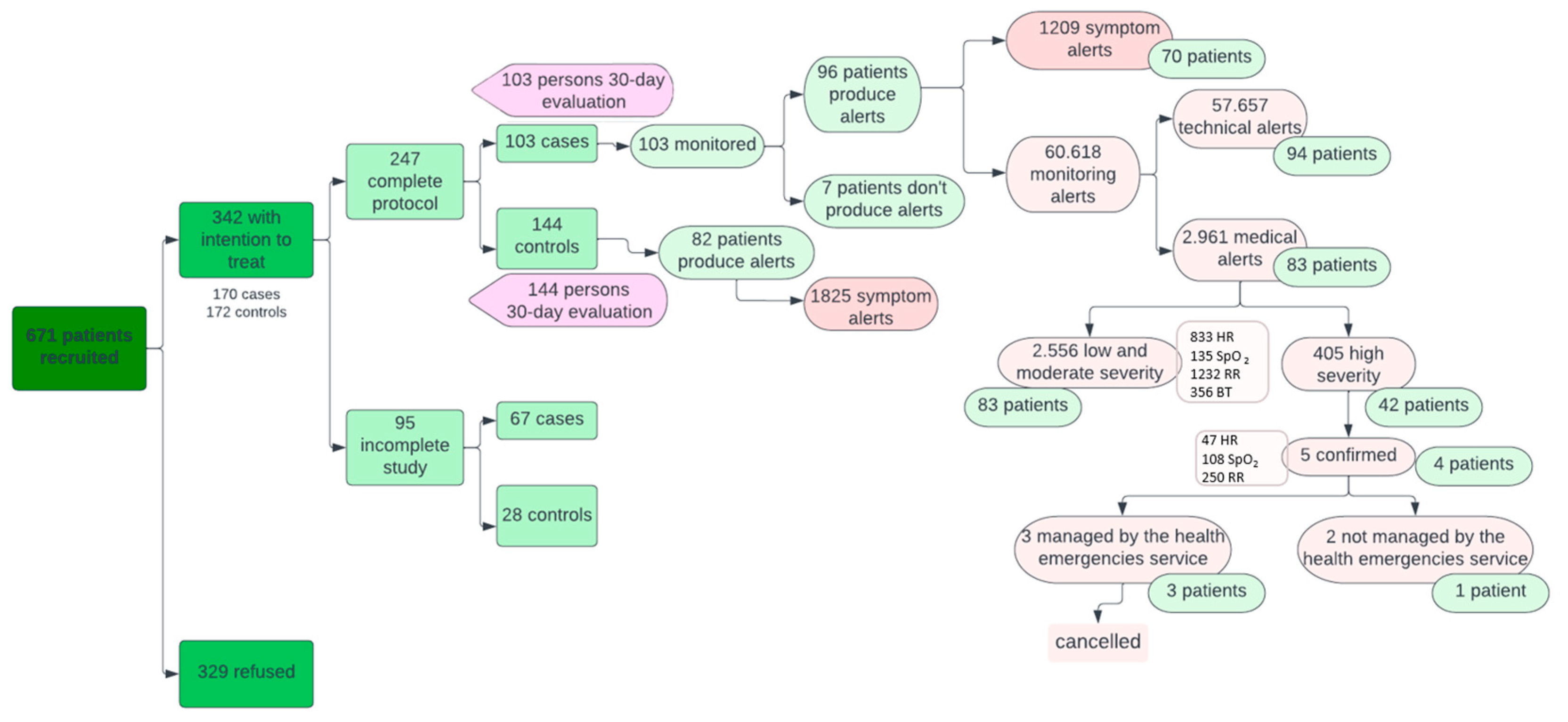Randomized Controlled Trial to Assess the Feasibility of a Novel Clinical Decision Support System Based on the Automatic Generation of Alerts through Remote Patient Monitoring
Abstract
1. Introduction
2. Materials and Methods
2.1. Study Design
2.2. Study Setting
2.3. Study Variables
- -
- Baseline variables under study were age, sex, date of positive COVID-19 diagnosis, diagnostic method (polymerase chain reaction or antigen test), COVID-19 vaccination schedule (number of vaccinations and type), and comorbidities with a high risk of severe disease progression.
- -
- Variables of the conventional clinical assessment questionnaire carried out by telephone by primary care professionals for home follow-up of patients with COVID-19.
- -
- Clinical symptoms self-reported by patients using the mobile phone application for subsequent visualization by healthcare professionals: cough, fever, chest pain, dyspnea, vomiting, and diarrhea. Alterations in clinical symptoms produced alerts and the two groups were compared in terms of the number of alerts received and the ability of the system to resolve them autonomously.
- -
- Vital signs were monitored in real-time in the case group using the Bakeey E66 smartwatch (Shenzhen Yisi Technology Co. Ltd., Guangdong, China), which measures HR in beats per minute (bpm), RR in breaths per minute (bpm), and Tª in degrees Celsius (°C). In addition, the Wellue FS20F pulse oximeter (Wellue, Los Angeles, CA, USA) monitored blood oxygen saturation (SpO2) in percent (%). The system produced mild-moderate alerts for HR greater than 100 bpm, RR greater than 22 bpm, BT greater than 38 °C, or SpO2 less than 94%. It also produced severe alerts for HR greater than 120 or less than 50 bpm, RR greater than 30 or less than 9 bpm, BT greater than 39 °C, or SpO2 less than 92%.
- -
- Prognostic variables: were assessed 30 days after the date of positive COVID-19 diagnosis. To reduce the risk of error, the evaluation was carried out by an external clinical specialized committee on infectious diseases. Primary variables were progression to pneumonia, need for intensive care unit (ICU) admission, need for invasive mechanical ventilation, and mortality rate. Secondary outcomes were hospital admission rate, mean hospital stay, the occurrence of major vascular events, and the economic cost of hospital care.
2.4. CDSS
2.5. Data and Information Management in the Institutions
2.6. Statistical Analysis
2.7. Ethical Considerations
3. Results
3.1. Description of the Study Sample
3.2. Clinical Prognostic Variables and the Evolution of Both Groups
3.3. Emission and Management of Alerts
3.4. Baseline Factors Associated with Medical Alert Production
4. Discussion
5. Conclusions
Supplementary Materials
Author Contributions
Funding
Institutional Review Board Statement
Informed Consent Statement
Data Availability Statement
Conflicts of Interest
References
- Marani, M.; Katul, G.G.; Pan, W.K.; Parolari, A.J. Intensity and frequency of extreme novel epidemics. Proc. Natl. Acad. Sci. USA 2021, 118, e2105482118. [Google Scholar] [CrossRef] [PubMed]
- Simpson, S.; Kaufmann, M.C.; Glozman, V.; Chakrabarti, A. Disease X: Accelerating the development of medical countermeasures for the next pandemic. Lancet Infect. Dis. 2020, 20, e108–e115. [Google Scholar] [CrossRef] [PubMed]
- Hassoun, N.; Basu, K.; Gostin, L. Pandemic preparedness and response: A new mechanism for expanding access to essential countermeasures. Health Econ. Policy Law. 2024, 1–24. [Google Scholar] [CrossRef] [PubMed]
- Glasby, J.; Litchfield, I.; Parkinson, S.; Hocking, L.; Tanner, D.; Roe, B.; Bousfield, J. New and emerging technology for adult social care—The example of home sensors with artificial intelligence (AI) technology. Health Soc. Care Deliv. Res. 2023, 11, 1–64. [Google Scholar] [CrossRef] [PubMed]
- Muralitharan, S.; Nelson, W.; Di, S.; McGillion, M.; Devereaux, P.; Barr, N.G.; Petch, J. Machine Learning–Based Early Warning Systems for Clinical Deterioration: Systematic Scoping Review. J. Med. Internet Res. 2021, 23, e25187. [Google Scholar] [CrossRef]
- Sabry, F.; Eltaras, T.; Labda, W.; Alzoubi, K.; Malluhi, Q. Machine Learning for Healthcare Wearable Devices: The Big Picture. J. Healthc. Eng. 2022, 2022, 4653923. [Google Scholar] [CrossRef]
- Chatterjee, A.; Prinz, A.; Riegler, M.A.; Das, J. A systematic review and knowledge mapping on ICT-based remote and automatic COVID-19 patient monitoring and care. BMC Health Serv. Res. 2023, 30, 1047. [Google Scholar] [CrossRef]
- Annis, T.; Pleasants, S.; Hultman, G.; Lindemann, E.; A Thompson, J.; Billecke, S.; Badlani, S.; Melton, G.B. Rapid implementation of a COVID-19 remote patient monitoring program. J. Am. Med. Inform. Assoc. 2020, 27, 1326–1330. [Google Scholar] [CrossRef]
- Mao, L.; Mohan, G.; Normand, C. Use of information communication technologies by older people and telemedicine adoption during COVID-19: A longitudinal study. J. Am. Med. Inform. Assoc. 2023, 30, 2012–2020. [Google Scholar] [CrossRef]
- Al-Rawashdeh, M.; Keikhosrokiani, P.; Belaton, B.; Alawida, M.; Zwiri, A. IoT Adoption and Application for Smart Healthcare: A Systematic Review. Sensors 2022, 19, 5377. [Google Scholar] [CrossRef]
- Pont, M.V.; Rodríguez MC, S.; Blanc, N.P.; PInsach, L. Impact of implementing new technologies to innovate and transform primary care: The technology nurse. Aten. Prim. Pract. 2021, 3, 100116. [Google Scholar]
- Baumgärtel, D.; Mielke, C.; Haux, R. A Review of Decision Support Systems for Smart Homes in the Health Care System. Stud. Health Technol. Inform. 2018, 247, 476–480. [Google Scholar] [CrossRef]
- Mitratza, M.; Goodale, B.M.; Shagadatova, A.; Kovacevic, V.; van de Wijgert, J.; Brakenhoff, T.B.; Dobson, R.; Franks, B.; Veen, D.; Folarin, A.A.; et al. The performance of wearable sensors in the detection of SARS-CoV-2 infection: A systematic review. Lancet Digit. Health 2022, 4, e370–e383. [Google Scholar] [CrossRef] [PubMed]
- Sodhro, A.H.; Zahid, N. AI-Enabled Framework for Fog Computing Driven E-Healthcare Applications. Sensors 2021, 21, 8039. [Google Scholar] [CrossRef] [PubMed]
- Alcoceba-Herrero, I.; Coco-Martín, M.B.; Leal-Vega, L.; Martín-Gutiérrez, A.; Diego, L.P.-D.; Dueñas-Gutiérrez, C.; de Castro-Rodríguez, F.; Royuela-Ruiz, P.; Arenillas-Lara, J.F. Randomized controlled trial evaluating the benefit of a novel clinical decision support system for the management of COVID-19 Patients in Home Quarantine: A Study Protocol. Int. J. Environ. Res. Public. Health 2023, 20, 2300. [Google Scholar] [CrossRef] [PubMed]
- Un, K.-C.; Wong, C.-K.; Lau, Y.-M.; Lee, J.C.-Y.; Tam, F.C.-C.; Lai, W.-H.; Lau, Y.-M.; Chen, H.; Wibowo, S.; Zhang, X.; et al. Observational study on wearable biosensors and machine learning-based remote monitoring of COVID-19 patients. Sci. Rep. 2021, 11, 4388. [Google Scholar] [CrossRef]
- Takahashi, S.; Nakazawa, E.; Ichinohe, S.; Akabayashi, A.; Akabayashi, A. Wearable Technology for Monitoring Respiratory Rate and SpO2 of COVID-19 Patients: A Systematic Review. Diagnostics 2022, 12, 2563. [Google Scholar] [CrossRef]
- Kondylakis, H.; Katehakis, D.G.; Kouroubali, A.; Logothetidis, F.; Triantafyllidis, A.; Kalamaras, I.; Votis, K.; Tzovaras, D. COVID-19 Mobile Apps: A Systematic Review of the Literature. J. Med. Internet Res. 2020, 22, e23170. [Google Scholar] [CrossRef]
- Xu, H.; Huang, S.; Qiu, C.; Liu, S.; Deng, J.; Jiao, B.; Tan, X.; Ai, L.; Xiao, Y.; Belliato, M.; et al. Monitoring and Management of Home-Quarantined Patients with COVID-19 Using a WeChat-Based Telemedicine System: Retrospective Cohort Study. J. Med. Internet Res. 2020, 22, e19514. [Google Scholar] [CrossRef]
- Faris, H.; Habib, M.; Faris, M.; Elayan, H.; Alomari, A. An intelligent multimodal medical diagnosis system based on patients’ medical questions and structured symptoms for telemedicine. Inform. Med. Unlocked 2021, 23, 100513. [Google Scholar] [CrossRef]
- van Goor, H.M.; Breteler, M.J.; van Loon, K.; de Hond, T.A.; Reitsma, J.B.; Zwart, D.L.; Kalkman, C.J.; Kaasjager, K.A. Remote Hospital Care for Recovering COVID-19 Patients Using Telemedicine: A Randomised Controlled Trial. J. Clin. Med. 2021, 10, 5940. [Google Scholar] [CrossRef] [PubMed]
- Vindrola-Padros, C.; Singh, K.E.; Sidhu, M.S.; Georghiou, T.; Sherlaw-Johnson, C.; Tomini, S.M.; Inada-Kim, M.; Kirkham, K.; Streetly, A.; Cohen, N.; et al. Remote home monitoring (virtual wards) for confirmed or suspected COVID-19 patients: A rapid systematic review. EClinicalMedicine 2021, 37, 100965. [Google Scholar] [CrossRef] [PubMed]
- Beaney, T.; Neves, A.L.; Alboksmaty, A.; Ashrafian, H.; Flott, K.; Fowler, A.; Benger, J.R.; Aylin, P.; Elkin, S.; Darzi, A.; et al. Trends and associated factors for COVID-19 hospitalization and fatality risk in 2.3 million adults in England. Nat. Commun. 2022, 13, 2356. [Google Scholar] [CrossRef] [PubMed]
- Williamson, E.J.; Walker, A.J.; Bhaskaran, K.; Bacon, S.; Bates, C.; Morton, C.E.; Curtis, H.J.; Mehrkar, A.; Evans, D.; Inglesby, P.; et al. OpenSAFELY: Factors associated with COVID-19 death in 17 million patients. Nature 2020, 584, 430–446. [Google Scholar] [CrossRef] [PubMed]
- Wurzer, D.; Spielhagen, P.; Siegmann, A.; Gercekcioglu, A.; Gorgass, J.; Henze, S.; Kolar, Y.; Koneberg, F.; Kukkonen, S.; McGowan, H.; et al. Remote monitoring of COVID-19 positive high-risk patients in domestic isolation: A feasibility study. PLoS ONE 2021, 16, e0257095. [Google Scholar] [CrossRef]
- Bauerly, B.C.; McCord, R.F.; Hulkower, R.; Pepin, D. Broadband Access as a Public Health Issue: The Role of Law in Expanding Broadband Access and Connecting Underserved Communities for Better Health Outcomes. J. Law Med. Ethics 2019, 47, 39–42. [Google Scholar] [CrossRef]
- Casariego-Vales, E.; Blanco-López, R.; Rosón-Calvo, B.; Suárez-Gil, R.; Santos-Guerra, F.; Dobao-Feijoo, M.J.; Ares-Rico, R.; Bal-Alvaredo, M.; on behalf of the TELEA-COVID Lugo Comanagement Team. Efficacy of Telemedicine and Telemonitoring in At-Home Monitoring of Patients with COVID-19. J. Clin. Med. 2021, 10, 2893. [Google Scholar] [CrossRef]
- Lee, J.M.; Jansen, R.; E Sanderson, K.; Guerra, F.; Keller-Olaman, S.; Murti, M.; O’sullivan, T.L.; Law, M.P.; Schwartz, B.; E Bourns, L.; et al. Public health emergency preparedness for infectious disease emergencies: A scoping review of recent evidence. BMC Public. Health 2023, 23, 42. [Google Scholar] [CrossRef]
- Schulz, K.F.; Altman, D.G.; Moher, D. CONSORT 2010 Statement: Updated guidelines for reporting parallel group randomised trials. BMC Med. 2010, 8, 18. [Google Scholar] [CrossRef]




| Control Group | Intervention Group |
|---|---|
|
|
|
|
|
| Variables | Cases n (%) | Controls n (%) | p-Value |
|---|---|---|---|
| Men Women | 52 (50.5%) 51 (49.5%) | 54 (37.5%) 90 (62.5%) | 0.04 * |
| <30 years old 30–45 years 46–65 years >65 years | 13 (12.6%) 39 (37.9%) 46 (44.7%) 5 (4.9%) | 28 (19.4%) 55 (38.2%) 57 (39.6%) 4 (2.8%) | 0.43 |
| COVID-19 PCR test positive COVID-19 antigen test positive | 69 (67.0%) 34 (33.0%) | 96 (66.7%) 48 (33.3%) | 0.96 |
| COVID-19 vaccinated | 69 (67.0%) | 102 (70.8%) | 0.51 |
| High blood pressure Diabetes mellitus Obesity Dyslipidemia Atrial fibrillation Myocardial infarction Asthma Bronchitis COPD Stroke Liver disease Neoplasia Chronic renal failure | 10 (9.7%) 3 (2.9%) 10 (9.7%) 17 (16.5%) 1 (1.0%) 0 (0.0%) 8 (7.8%) 0 (0.0%) 2 (1.9%) 0 (0.0%) 1 (1.0%) 0 (0.0%) 0 (0.0%) | 11 (7.6%) 3 (2.1%) 13 (9.0%) 15 (10.4%) 4 (2.8%) 1 (0.7%) 10 (6.9%) 1 (0.7%) 0 (0.0%) 3 (2.1%) 0 (0.0%) 4 (2.8%) 1 (0.7%) | 0.57 0.68 0.86 0.16 0.32 0.4 0.81 0.4 0.09 0.14 0.24 0.09 0.4 |
| Corticosteroids Immunosuppressive biological therapy | 3 (2.9%) 0 (0.0%) | 5 (3.5%) 5 (3.5%) | 0.8 0.06 |
| Variables | n | Chi-Square p-Value | Cramér’s V |
|---|---|---|---|
| Men Women | 225 180 | 0.36 | 0.02 |
| <30 years old 30–45 years 46–65 years >65 years | 9 78 304 14 | <0.001 | 0.08 |
| COVID-19 PCR test positive COVID-19 antigen test positive | 356 49 | 0.72 | 0.01 |
| HR SpO2 RR | 47 108 250 | <0.001 | 0.33 |
| High blood pressure Diabetes mellitus Obesity Dyslipidemia Atrial fibrillation Asthma COPD | 27 4 22 113 3 56 3 | <0.001 0.11 0.21 <0.001 0.47 <0.001 0.90 | 0.15 0.03 0.03 0.07 0.01 0.09 0.01 |
| Corticosteroids | 20 | <0.001 | 0.33 |
Disclaimer/Publisher’s Note: The statements, opinions and data contained in all publications are solely those of the individual author(s) and contributor(s) and not of MDPI and/or the editor(s). MDPI and/or the editor(s) disclaim responsibility for any injury to people or property resulting from any ideas, methods, instructions or products referred to in the content. |
© 2024 by the authors. Licensee MDPI, Basel, Switzerland. This article is an open access article distributed under the terms and conditions of the Creative Commons Attribution (CC BY) license (https://creativecommons.org/licenses/by/4.0/).
Share and Cite
Alcoceba-Herrero, I.; Coco-Martín, M.B.; Jiménez-Pérez, J.M.; Leal-Vega, L.; Martín-Gutiérrez, A.; Dueñas-Gutiérrez, C.; Miramontes-González, J.P.; Corral-Gudino, L.; de Castro-Rodríguez, F.; Royuela-Ruiz, P.; et al. Randomized Controlled Trial to Assess the Feasibility of a Novel Clinical Decision Support System Based on the Automatic Generation of Alerts through Remote Patient Monitoring. J. Clin. Med. 2024, 13, 5974. https://doi.org/10.3390/jcm13195974
Alcoceba-Herrero I, Coco-Martín MB, Jiménez-Pérez JM, Leal-Vega L, Martín-Gutiérrez A, Dueñas-Gutiérrez C, Miramontes-González JP, Corral-Gudino L, de Castro-Rodríguez F, Royuela-Ruiz P, et al. Randomized Controlled Trial to Assess the Feasibility of a Novel Clinical Decision Support System Based on the Automatic Generation of Alerts through Remote Patient Monitoring. Journal of Clinical Medicine. 2024; 13(19):5974. https://doi.org/10.3390/jcm13195974
Chicago/Turabian StyleAlcoceba-Herrero, Irene, María Begoña Coco-Martín, José María Jiménez-Pérez, Luis Leal-Vega, Adrián Martín-Gutiérrez, Carlos Dueñas-Gutiérrez, José Pablo Miramontes-González, Luis Corral-Gudino, Flor de Castro-Rodríguez, Pablo Royuela-Ruiz, and et al. 2024. "Randomized Controlled Trial to Assess the Feasibility of a Novel Clinical Decision Support System Based on the Automatic Generation of Alerts through Remote Patient Monitoring" Journal of Clinical Medicine 13, no. 19: 5974. https://doi.org/10.3390/jcm13195974
APA StyleAlcoceba-Herrero, I., Coco-Martín, M. B., Jiménez-Pérez, J. M., Leal-Vega, L., Martín-Gutiérrez, A., Dueñas-Gutiérrez, C., Miramontes-González, J. P., Corral-Gudino, L., de Castro-Rodríguez, F., Royuela-Ruiz, P., & Arenillas-Lara, J. F. (2024). Randomized Controlled Trial to Assess the Feasibility of a Novel Clinical Decision Support System Based on the Automatic Generation of Alerts through Remote Patient Monitoring. Journal of Clinical Medicine, 13(19), 5974. https://doi.org/10.3390/jcm13195974







